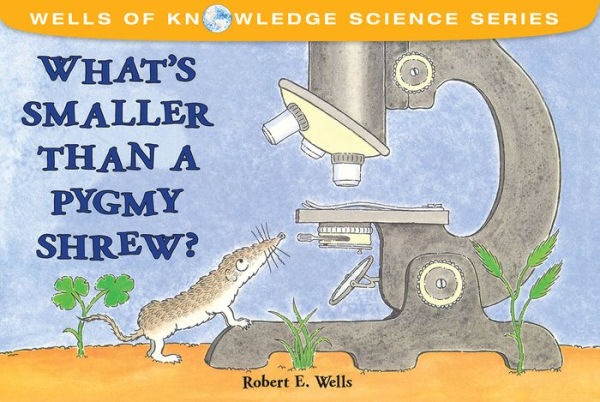Read an Excerpt
What's Smaller Than a Pygmy Shrew?
By Robert E. Wells ALBERT WHITMAN & Company
Copyright © 1995 Robert E. Wells
All rights reserved.
ISBN: 978-0-8075-8838-3
CHAPTER 1
How small would you say that small really is? Is something you can hold in your hand, like a blueberry, small? How about a grain of sand?
Yes, it's true we could call those things small. But in this book, you'll find much, MUCH smaller things—things you cannot ordinarily see.
Unless, of course, you look through a MICROSCOPE.
An ordinary (optical) microscope bends light rays in a way that makes objects appear larger than they really are. With this you can see things you may not have known existed. You can discover, for example, that many tiny creatures live inside a single water drop. But did you know that there is a world of things too small to be seen with an ordinary microscope? To see these things, you need to use a much more powerful instrument-an electron microscope, which uses electrons rather than light rays to scan images. This is the kind that many scientists use.
The world of the Very Small is almost unbelievably tiny, and hard to imagine. But it's quite real. In fact, it's just as real as a blueberry.
Everyone knows you can stretch your mind by thinking big. Do you suppose it's also possible to stretch your mind by thinking small?
This is a PYGMY SHREW. From the end of her nose to the tip of her tail, she's only about 3 inches (7 ½ centimeters) long.
If you were a pygmy shew, you'd feel mighty small. Even some TOADS TOOLS would be taller than you!
If you happened to meet an ELEPHANT, you'd probably think you were the smallest thing in the UNIVERSE!
Compared to an elephant, the largest land mammal, she looks very small indeed.
But pygmy shrew, you're not so small. Not compared to a LADY BUG.
Lady bugs are a kind of beetle, and beetles are just one of the many kinds of insects. Pygmy shrews are insect eaters, but they prefer to leave lady bugs alone. They know that lady bugs have a bitter taste!
(Continues...)
Excerpted from What's Smaller Than a Pygmy Shrew? by Robert E. Wells. Copyright © 1995 Robert E. Wells. Excerpted by permission of ALBERT WHITMAN & Company.
All rights reserved. No part of this excerpt may be reproduced or reprinted without permission in writing from the publisher.
Excerpts are provided by Dial-A-Book Inc. solely for the personal use of visitors to this web site.



